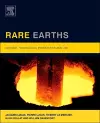
Rare Earths
5 authors - Hardback
£142.00
Professor Jacques Lucas is a Ph.D. (University of Rennes, France) in solid state chemistry. He is a member of the French Academy of Sciences and Emeritus professor at the University of Rennes. He has co-authored several books on glasses, ceramics and optics. He has been involved in rare earths research (photonics) as well as teaching for more than 40 years .He published more than 450 articles and co-chaired several international conferences devoted to rare earths doped optical materials. He founded and headed the CNRS Glass and Ceramic laboratory at University of Rennes for 30 years. Three start-up companies were founded based on the laboratory discoveries. He has been associate professor at University of Arizona and invited professor at Kyoto University (Japan) as well as at Shanghai University (China). He is in close contact with Solvay, the world leading company in rare earth separation, as well as with the Chinese and Japanese rare earth scientific community. Professor Pierre Lucas is a PhD (Arizona State U.) in physical chemistry. He is a professor of Materials Science and Engineering leading several funded research projects on rare-earth doped luminescent glasses. He has been temporarily employed as an analytical chemist at Rhodia’s rare-earth refining plant in France. He is author of more than 60 peer-reviewed journal articles and book chapters in solid state physics and chemistry. Doctor Le Mercier is a PhD (University of Paris) with a specialty in solid state chemistry and optical properties of inorganic materials. He has been working for Solvay (previously Rhodia), a world-leading company in rare earths, for 16 years. He is currently the head of research and development department focused on new inorganic materials and breakthrough developments for energy applications and sustainable resources. He has been developing new rare earths phosphor materials for lighting and display systems. He is author of more than 30 patents is this field. Alain Rollat holds a Ph.D. (University of Strasbourg, France) in chemistry and chemical engineering and an MBA degree from Poitiers University (Poitiers, France). He has been working in the rare earths industry (Rhône-Poulenc, Rhodia and Solvay) for more than 30 years, both in the Aubervilliers Research Center and in the La Rochelle plant. During this period, he has developed several processes in the field of rare earths separation and purification (12 patents) and also participated in the design and startup of new production units of rare earths in France and China. He is currently Technology Development Manager in charge of new processes implementation for the 5 plants of Solvay Rare Earth Systems, a Business Unit of Solvay group. He is also in charge of new rare earths sourcing for Solvay, and in this capacity, he has been working over the last 5 years with the main rare earths mining projects around the world. Professor William George Davenport is a graduate of the University of British Columbia and the Royal School of Mines, London. Prior to his academic career he worked with the Linde Division of Union Carbide in Tonawanda, New York. He spent a combined 43 years of teaching at McGill University and the University of Arizona. His Union Carbide days are recounted in the book Iron Blast Furnace, Analysis, Control and Optimization (English, Chinese, Japanese, Russian and Spanish editions). During the early years of his academic career he spent his summers working in many of Noranda Mines Company’s metallurgical plants, which led quickly to the book Extractive Metallurgy of Copper. This book has gone into five English language editions (with several printings) and Chinese, Farsi and Spanish language editions. He also had the good fortune to work in Phelps Dodge’s Playas flash smelter soon after coming to the University of Arizona. This experience contributed to the book Flash Smelting, with two English language editions and a Russian language edition and eventually to the book Sulfuric Acid Manufacture (2006), 2nd edition 2013. In 2013 co-authored Extractive Metallurgy of Nickel, Cobalt and Platinum Group Metals, which took him to all the continents except Antarctica. He and four co-authors are just finishing up the book Rare Earths: Science, Technology, Production and Use, which has taken him around the United States, Canada and France, visiting rare earth mines, smelters, manufacturing plants, laboratories and recycling facilities. Professor Davenport’s teaching has centered on ferrous and non-ferrous extractive metallurgy. He has visited (and continues to visit) about 10 metallurgical plants per year around the world to determine the relationships between theory and industrial practice. He has also taught plant design and economics throughout his career and has found this aspect of his work particularly rewarding. The delight of his life at the university has, however, always been academic advising of students on a one-on-one basis. Professor Davenport is a Fellow (and life member) of the Canadian Institute of Mining, Metallurgy and Petroleum and a twenty-five year member of the (U.S.) Society of Mining, Metallurgy and Exploration. He is recipient of the CIM Alcan Award, the TMS Extractive Metallurgy Lecture Award, the AusIMM Sir George Fisher Award, the AIME Mineral Industry Education Award, the American Mining Hall of Fame Medal of Merit and the SME Milton E. Wadsworth award. In September 2014 he will be honored by the Conference of Metallurgists’ Bill Davenport Honorary Symposium in Vancouver, British Columbia (his home town).